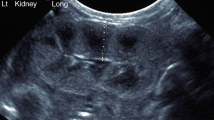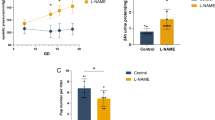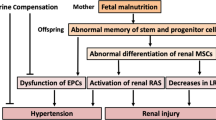Abstract
There is evidence that fetal growth restriction is associated with impaired nephrogenesis and reduced numbers of mature nephrons at birth. It has been proposed that such impairment of renal growth may contribute to increased blood pressure in later life. Although prostaglandins (PG) play a key role in kidney development, it is unknown whether a poor fetal substrate supply alters the synthesis or actions of PG within the fetal kidney. Using real-time reverse transcriptase PCR, we have measured the effect of chronic placental restriction (PR) on the renal expression of PG endoperoxide G/H synthase-2 (PGHS-2), PGE2 receptors EP2 and EP4, and renin mRNA in the sheep fetus in late gestation. Restriction of placental growth reduced fetal body weight (PR: 3.2 ± 0.2 kg, control: 4.8 ± 0.2 kg) and total kidney weight (PR: 19.7 ± 1.8 g, control: 25.1 ± 1.3 g). Mean fetal arterial Po2 was reduced by PR (PR: 15.03 ± 0.67 mm Hg, control: 21.3 ± 0.87 mm Hg). Renal PGHS-2 mRNA was increased in the PR group (PR: 2.26 ± 0.38, control: 1.20 ± 0.31) and was inversely related to mean fetal arterial Po2 in the PR and control groups [PGHS-2: −0.17 (Po2) + 4.69, r2 = 0.26]. PR also increased renal EP2 (PR: 1.57 + 0.24, control: 0.82 + 0.13) but not EP4 mRNA. Renin mRNA was directly related to renal EP2 [renin = 0.37 (EP2) + 0.97, r2 = 0.29] and EP4, [renin = 0.75 (EP4) + 0.44, r2 = 0.38] mRNA expression. Thus, the restriction of placental growth and associated chronic hypoxemia appear to increase the renal capacity to synthesize and respond to PG, which may play an important role in maintaining renin mRNA expression in the growth-restricted fetus.
Similar content being viewed by others
Log in or create a free account to read this content
Gain free access to this article, as well as selected content from this journal and more on nature.com
or
References
Barker DJ 1995 Fetal origins of coronary heart disease. BMJ 311: 171–174
Barker D 1998 Mothers, Babies and Health in Later Life. Churchill Livingstone, Edinburgh, Scotland, p 217
Barker DJP 1999 Fetal programming and public health. In: O'Brien PMS, Wheeler T, Barker DJP (eds) Fetal Programming: Influences on Development and Disease in Later Life. RCOG Press, London, pp 3–11
Lucas A 1991 Programming by early nutrition in man. In: Bock GR, Whelen J (eds) The Childhood Environment and Adult Disease. John Wiley & Sons, Chichester, England, pp 38–55
Hinchliffe SA, Lynch MR, Sargent PH, Howard CV, Van Velzen D 1992 The effect of intrauterine growth retardation on the development of renal nephrons. Br J Obstet Gynaecol 99: 296–301
Bassan H, Trejo L, Kariv N, Bassan M, Berger E, Fattal A, Gozes I, Harel S 2000 Experimental intrauterine growth retardation alters renal development. Pediatr Nephrol 15: 192–195
Vehaskari VM, Aviles DH, Manning J 2001 Prenatal programming of adult hypertension in the rat. Kidney Int 59: 238–245
Gleason CA 1987 Prostaglandins and the developing kidney. Semin Perinatol 11: 12–21
Dinchuk JE, Car BD, Focht RJ, Johnston JJ, Jaffee BD, Covington MB, Contel NR, Eng VM, Collins RJ, Czerniak PM 1995 Renal abnormalities and an altered inflammatory response in mice lacking cyclooxygenase II. Nature 378: 406–409
van der Heijden BJ, Carlus C, Narcy F, Bavoux F, Delezoide AL, Gubler MC 1994 Persistent anuria, neonatal death, and renal microcystic lesions after prenatal exposure to indomethacin. Am J Obstet Gynecol 171: 617–623
Kaplan BS, Restaino I, Raval DS, Gottlieb RP, Bernstein J 1994 Renal failure in the neonate associated with in utero exposure to non-steroidal anti-inflammatory agents. Pediatr Nephrol 8: 700–704
Komhoff M, Wang JL, Cheng HF, Langenbach R, McKanna JA, Harris RC, Breyer MD 2000 Cyclooxygenase-2-selective inhibitors impair glomerulogenesis and renal cortical development. Kidney Int 57: 414–422
Novy MJ 1978 Effects of indomethacin on labor, fetal oxygenation, and fetal development in rhesus monkeys. Adv Prostaglandin Thromboxane Res 4: 285–300
Matson JR, Stokes JB, Robillard JE 1981 Effects of inhibition of prostaglandin synthesis on fetal renal function. Kidney Int 20: 621–627
Stevenson KM, Lumbers ER 1992 Effects of indomethacin on fetal renal function, renal and umbilicoplacental blood flow and lung liquid production. J Dev Physiol 17: 257–264
Zhang MZ, Wang JL, Cheng HF, Harris RC, McKanna JA 1997 Cyclooxygenase-2 in rat nephron development. Am J Physiol 273: F994–F1002
Pace-Asciak CR 1977 Prostaglandin biosynthesis and catabolism in the developing fetal sheep kidney. Prostaglandins 13: 661–668
Breyer MD, Harris RC 2001 Cyclooxygenase 2 and the kidney. Curr Opin Nephrol Hypertens 10: 89–98
Zhang DY, Lumbers ER, Simonetta G 1996 Changes in renal renin gene expression in fetal sheep. Clin Exp Pharmacol Physiol 23: 682–684
Tufro-McReddie A, Romano LM, Harris JM, Ferder L, Gomez RA 1995 Angiotensin II regulates nephrogenesis and renal vascular development. Am J Physiol 269: F110–F115
Lumbers ER, Burrell JH, Menzies RI, Stevens AD 1993 The effects of a converting enzyme inhibitor (captopril) and angiotensin II on fetal renal function. Br J Pharmacol 110: 821–827
Takae K, Wu WX, Nathanielsz PW Characterization of developmental changes of prostaglandin (PG) E and F receptor subtypes in the fetal sheep kidney in late gestation. Proceedings of the Society for Gynecologic Investigation, Chicago, IL, pp
Robinson JS, Kingston EJ, Jones CT, Thorburn GD 1979 Studies on experimental growth retardation in sheep. The effect of removal of endometrial caruncles on fetal size and metabolism. J Dev Physiol 1: 379–398
McMillen IC, Warnes KE, Adams MB, Robinson JS, Owens JA, Coulter CL 2000 Impact of restriction of placental and fetal growth on expression of 11beta-hydroxysteroid dehydrogenase type 1 and type 2 messenger ribonucleic acid in the liver, kidney, and adrenal of the sheep fetus. Endocrinology 141: 539–543
Pfaffl MW 2001 A new mathematical model for relative quantification in real-time RT-PCR. Nucleic Acids Res 29: 2002–2007
Hartner A, Pahl A, Brune K, Goppelt-Struebe M 2000 Upregulation of cyclooxygenase-1 and the PGE2 receptor EP2 in rat and human mesangioproliferative glomerulonephritis. Inflamm Res 49: 345–354
Millard RW, Baig H, Vatner SF 1979 Prostaglandin control of the renal circulation in response to hypoxemia in the fetal lamb in utero. Circ Res 45: 172–179
Bauer R, Walter B, Zwiener U 2000 Effect of severe normocapnic hypoxia on renal function in growth-restricted newborn piglets. Am J Physiol 279: R1010–R1016
Schmedtje JFJ, Ji YS, Liu WL, DuBois RN, Runge MS 1997 Hypoxia induces cyclooxygenase-2 via the NF-kappaB p65 transcription factor in human vascular endothelial cells. J Biol Chem 272: 601–608
Semenza GL 2001 HIF-1 and mechanisms of hypoxia sensing. Curr Opin Cell Biol 13: 167–171
Kurtz A, Jelkmann W, Pfeischifter J, Bauer C 1985 Role of prostaglandins in hypoxia-stimulated erythropoietin production. Am J Physiol 249: C3–C8
Phillips ID, Simonetta G, Owens JA, Robinson JS, Clarke IJ, McMillen IC 1996 Placental restriction alters the functional development of the pituitary-adrenal axis in the sheep fetus during late gestation. Pediatr Res 40: 861–866
Jensen BL, Stubbe J, Hansen PB, Andreasen D, Skott O 2001 Localization of prostaglandin E(2) EP2 and EP4 receptors in the rat kidney. Am J Physiol 280: F1001–F1009
Morath R, Klein T, Seyberth HW, Nusing RM 1999 Immunolocalization of the four prostaglandin E2 receptor proteins EP1, EP2, EP3, and EP4 in human kidney. J Am Soc Nephrol 10: 1851–1860
Tilley SL, Audoly LP, Hicks EH, Kim HS, Flannery PJ, Coffman TM, Koller BH 1999 Reproductive failure and reduced blood pressure in mice lacking the EP2 prostaglandin E2 receptor. J Clin Invest 103: 1539–1545
Kennedy CR, Zhang Y, Brandon S, Guan Y, Coffee K, Funk CD, Magnuson MA, Oates JA, Breyer MD, Breyer RM 1999 Salt-sensitive hypertension and reduced fertility in mice lacking the prostaglandin EP2 receptor. Nat Med 5: 217–220
Breyer M, Breyer R 2000 Prostaglandin E receptors and the kidney. Am J Physiol 279: F12–23
Narumiya S, Sugimoto Y, Ushikubi F 1999 Prostanoid receptors: structures, properties, and functions. Physiol Rev 79: 1193–1226
Coleman RA, Smith WL, Narumiya S 1994 International Union of Pharmacology classification of prostanoid receptors: properties, distribution, and structure of the receptors and their subtypes. Pharmacol Rev 46: 205–229
Nishigaki N, Negishi M, Ichikawa A 1996 Two Gs-coupled prostaglandin E receptor subtypes, EP2 and EP4, differ in desensitization and sensitivity to the metabolic inactivation of the agonist. Mol Pharmacol 50: 1031–1037
Zhang DY, Lumbers ER, Simonetta G, Wu JJ, Owens JA, Robinson JS, McMillen IC 2000 Effects of placental insufficiency on the ovine fetal renin-angiotensin system. Exp Physiol 85: 79–84
Woods LL, Ingelfinger JR, Nyengaard JR, Rasch R 2001 Maternal protein restriction suppresses the newborn renin-angiotensin system and programs adult hypertension in rats. Pediatr Res 49: 460–467
Edwards LJ, Simonetta G, Owens JA, Robinson JS, McMillen IC 1999 Restriction of placental and fetal growth in sheep alters fetal blood pressure responses to angiotensin II and captopril. J Physiol 515: 897–904
Author information
Authors and Affiliations
Corresponding author
Additional information
Supported by a grant from the Molly Towell Perinatal Research Foundation, the Canadian Institutes of Health Research, the Alberta Heritage Foundation for Medical Research, and the National Health and Medical Research Council of Australia.
Rights and permissions
About this article
Cite this article
Williams, S., McMillen, I., Zaragoza, D. et al. Placental Restriction Increases the Expression of Prostaglandin Endoperoxide G/H Synthase-2 and EP2 mRNA in the Fetal Sheep Kidney during Late Gestation. Pediatr Res 52, 879–885 (2002). https://doi.org/10.1203/00006450-200212000-00012
Received:
Accepted:
Issue date:
DOI: https://doi.org/10.1203/00006450-200212000-00012



